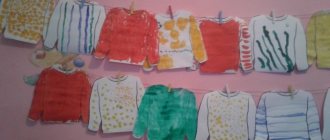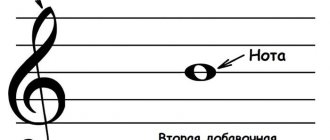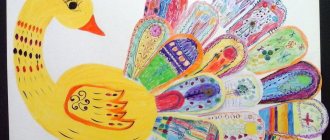“Everyone has their own home” Summary of joint educational activities with children of the middle group
Compiled by: Antipina Maria Robertovna
Teacher of the highest qualification category
Municipal autonomous preschool educational institution
kindergarten No. 42 general developmental type
with priority implementation of physical
development of children in the city of Tyumen
Summary of joint educational activities
with children of the middle group “Everyone has their own home”
Software tasks:
Area "Cognitive development"
1. Develop the ability to build according to a drawing, construct buildings from large and small building materials, use parts of different colors and sizes, identify the main parts, distinguish and correlate them by size and shape, establish the spatial arrangement of these parts relative to each other.
2.Develop the ability to work in subgroups.
3. Develop children's research activities: in cold weather, water turns into ice, in a warm room it melts.
Area "Speech development".
1.Improve dialogic speech: learn to participate in a conversation, answer and ask questions in a clear way for listeners.
Preliminary work:
Research activities with water.
Materials and equipment for joint activities:
Christmas trees for the forest, a hare toy, a river - fabric, modules for buildings, a large Lego set, video slides, diagrams.
Progress of activities:
Educator: Children, today I came to kindergarten and heard someone crying, I picked him up and brought him to the group. You will find out who it is when you solve the riddle.
"Long ear, little ball of fluff,
Jumps deftly, loves carrots!?”
Shows a bunny and asks: “What is it like?”
Children : Small, fluffy, long-eared......
Educator: What happened to you, bunny?
Bunny : I ran away from the forest
And, once in a big and noisy city
I'm confused,
I'm missing
not knowing the traffic lights,
I almost got hit by a car!
Educator : Why did you run away? Is it possible to do this?
Bunny : New Year is coming, everyone has their own houses in the forest, but I don’t. Where can I celebrate the holiday? I ran and ran, looking for a house, ran out of the forest and got lost.
Educator: What are we going to do? How can you help him? Presumable answers from the children: We need to return him to the forest, find his house or build him a new one...
Educator: How can you get to the forest?
Children: by bus, by car, on foot...
Educator: What's faster?
Children: by train...
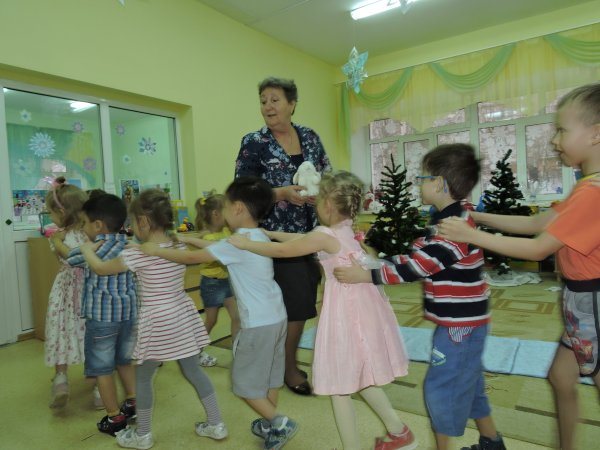
To the music of “Locomotive-Bug” we go into the forest.
Educator: We've arrived! How should you behave in the forest? Presumable answers from children: be quiet, don’t make noise.
Educator: Why? Presumable answers from children: do not scare the inhabitants of the forest...
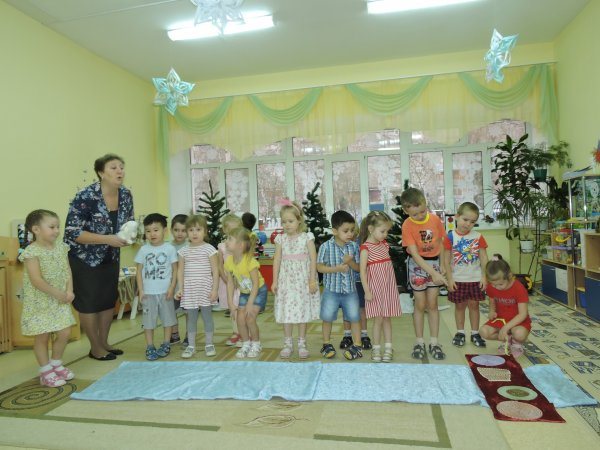
Children approach the “river”.
Educator: Look at the river on our way. What is she like?
Children: Wide, deep, long...
Educator: What is the name of the river that flows in our city?
Children: River Tura.
Educator: Guys, how can you get across the river in winter? Presumable answers from children: you can ride a sled; you can just cross the river;
Educator: Why can you easily cross the river in winter? Presumable children's answers: Because she was cold. The river was covered with ice.
Educator: Let's remember what we did the experiment with yesterday?
Children: With water.
Educator: Where did we pour the water?
Children: In jars.
Educator : These jars are in my train, let's take them and look at what happened to the water.
Children, under the guidance of a teacher, conduct research.
Educator: What happened to the water in this jar?

Children : She's frozen...
Educator: Why?
Children: Because I was outside all night.
Educator: What happened to the water in the second jar?
Children: Not cold...
Educator: Why?
Children: Because they only put the jar on the balcony in the morning.
The teacher offers to examine and touch the jars and the water in them.
Educator: Let's put the jars in the train, take them to the kindergarten and see in the evening whether changes will occur with the water.
Educator: Guys, let’s not take risks, in case the ice on our “river” is thin and let’s cross the bridge.

Educator : Look, there are some houses here.
On the screen there is a presentation of fairy-tale houses.
Educator: Bunny, can’t you see your house?
Bunny: My house is not here.
Educator: guys. What do all houses have in common?
Children : Everyone has a roof, windows, walls...
Educator: Bunny, then let's go to another clearing, maybe there we will find your house (the children move to another playroom).
Educator: What kind of snowdrift is this? What's hiding behind it?!
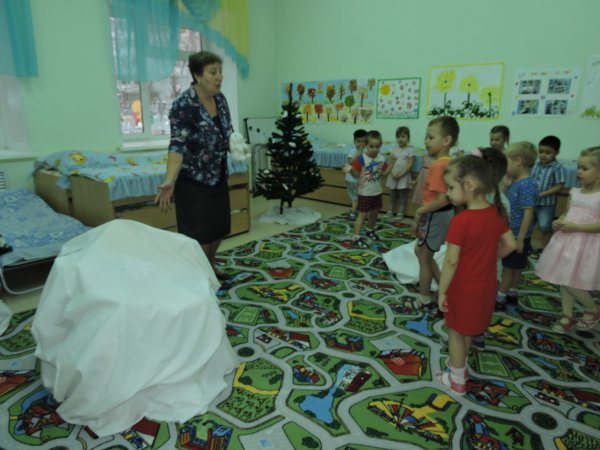
(children together with the teacher take out geometric shapes).
Educator: Look how many colored ice floes there are, what do they look like?
Children: On geometric shapes.
Educator: What do you think: is it possible to build a house from them?
Educator: Guys, before us, apparently, someone tried to build houses and left diagrams. You can use them or build your own house.
(Children are divided into two groups and build houses).
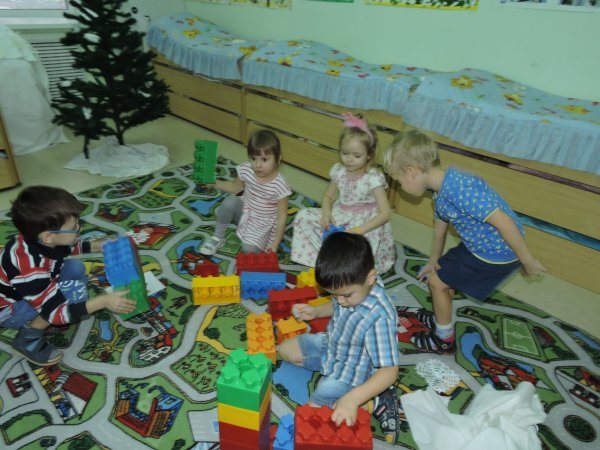
Bunny: Thank you! I really like both houses! I'll invite my friends to the party! And I want to treat you to my favorite carrots.
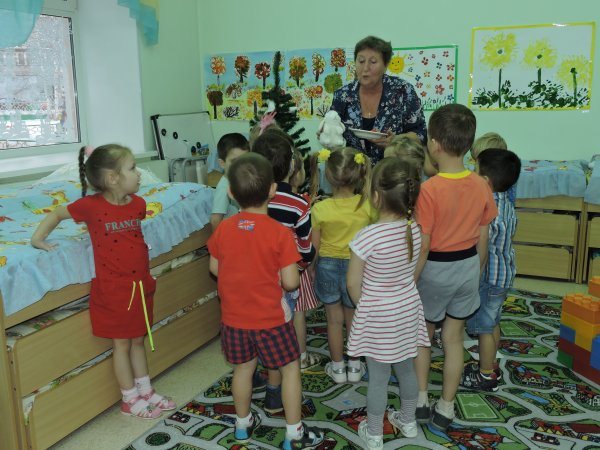
Educator: We know how many useful vitamins it contains...
“Remember the simple truth,
Only the one who sees better
Who chews raw carrots
Or drinks carrot juice!”
(To the music of “Locomotive-Bug” the children return to kindergarten).
Educator: You and I have come a long way, what will you tell mom and dad when you come home? (children's answers).
We invite teachers of preschool education in the Tyumen region, Yamal-Nenets Autonomous Okrug and Khanty-Mansi Autonomous Okrug-Yugra to publish their teaching materials: - Pedagogical experience, original programs, teaching aids, presentations for classes, electronic games; — Personally developed notes and scenarios of educational activities, projects, master classes (including videos), forms of work with families and teachers.
Why is it profitable to publish with us?
1. “Kindergartens of the Tyumen Region” is an officially registered specialized media outlet at the federal level. 2. The activities of the editorial office are supported by the Department of Education and Science of the Tyumen Region 3. We issue a “Certificate of Publication” in the media. 4. The document has a unique number, is entered in the register, has the original seal of the editorial office of the online publication and signature. 5. “Certificate of publication” in the media is sent to the author in both paper and electronic versions.
Details >>>
Sample “Certificate of publication of author’s methodological material in the media.”pdf
Share
